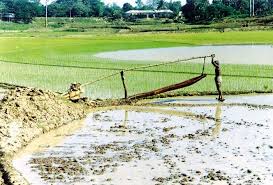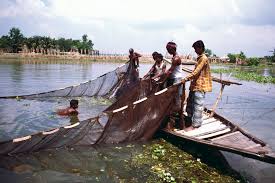 Bangladesh
Bangladesh has a primarily agrarian economy.
Agriculture is the single largest producing sector of the economy since it comprises about 18.6% (data released on November, 2010) of the country's
GDP and employs around 45% of the total labor force. The performance of this sector has an overwhelming impact on major macroeconomic objectives like
employment generation,
poverty alleviation, human resources development and
food security.
A plurality of Bangladeshis earns their living from
agriculture. Although
rice and
jute are the primary crops,
wheat is assuming greater importance.
Tea is grown in the northeast. Because of Bangladesh's fertile
soil and normally ample
water supply, rice can be grown and harvested three times a year in many areas. Due to a number of factors, Bangladesh's labor-intensive agriculture has achieved steady increases in food grain production despite the often unfavorable weather conditions. These include better flood control and
irrigation, a generally more efficient use of fertilizers, and the establishment of better distribution and rural credit networks. With 35.8 million metric tons produced in 2000, rice is Bangladesh's principal crop. National sales of the classes of
insecticide used on rice, including granular carbofuran, synthetic pyrethroids, and malathion exceeded 13,000 tons of formulated product in 2003 The insecticides not only represent an environmental threat, but are a significant expenditure to poor rice farmers. The
Bangladesh Rice Research Institute is working with various
NGOs and international organizations to reduce insecticide use in rice.


In comparison to rice, wheat output in 1999 was 1.9 million metric tons. Population pressure continues to place a severe burden on productive capacity, creating a food
deficit, especially of wheat. Foreign assistance and commercial
imports fill the gap.
Underemployment remains a serious problem, and a growing concern for Bangladesh's agricultural sector will be its ability to absorb additional manpower. Finding alternative sources of employment will continue to be a daunting problem for future governments, particularly with the increasing numbers of landless
peasants who already account for about half the rural labor force. Agriculture in Bangladesh is heavily dependent on the weather, and the entire harvest can be wiped out in a matter of hours when cyclones hit the country. According to the World Bank, the total arable land in Bangladesh is 61.2 percent of the total land area (down from 68.3 percent in 1980). Farms are usually very small due to heavily increasing population, unwieldy land ownership, and inheritance regulations. The 3 main crops—rice, jute, and tea—have dominated agricultural exports for decades, although the rice is grown almost entirely for domestic consumption, while jute and tea are the main export earners. In addition to these products, Bangladeshi farmers produce sugarcane, tobacco, cotton, and various fruits and vegetables (sweet potatoes, bananas, pineapples, etc.) for the domestic market.

Rice is the staple food in the everyday diet of Bangladeshis. The production of rice, which can be harvested 2 or even 3 times a year, reached 19.9 million metric tons in 1998-99. The production of wheat reached about 2 million metric tons in 1998-99. Both crops play an important role in achieving self-sufficiency in food production. However, due to weather conditions the production of rice and wheat fluctuate greatly, forcing Bangladesh to import food from the international market or turn to international aid. Bangladesh imported 1.6 million tons of wheat (mainly from the United States) in 2000 in order to meet the demand in the local market.


Jute, often called the "golden fibre" of Bengal, is the main export-earner for Bangladeshi agriculture, as Bangladesh remains the world's second-largest producer of jute (after India) and the world's largest exporter of fiber. Jute is traditionally used for the fiber of carpet backing, burlap bags, cheap paper, and various other purposes. Its importance for the Bangladeshi economy comes from the fact that almost 3 million farms are involved in jute production. In 1999 Bangladeshi export earnings from jute amounted to US$55 million, with the country producing 720,000 metric tons of jute, although this is about one-third of the jute production of the middle of the 1980s. The decline in jute production is attributed to declining world prices for this crop and to farmers switching to other crops.

Bangladesh also produces tea leaves, mainly for export, although the export of this product contributes only 1 percent of the country's
hard currency earnings. In 1998-99 the country produced 56,000 metric tons of tea leaves, but it could produce twice that amount. The main obstacle to increasing production is in falling prices for tea in the international market and in management and regulation problems in the industry in the country.
Tropical rainforest is important for maintaining the ecological balance in Bangladesh, and forestry contributes 1.9 percent to the GDP (1999-2000). The forest covers around 17 percent of the country's territory, or 2.5 million hectares (6.18 million acres). The timber is used by the construction industry as a source of building materials, by the printing industry as a source of materials to produce paper, and in the agricultural sector as a source of firewood. Commercial logging is limited to around 6.1 million cubic feet, and the government plans to plant more trees within the next 15 years.

Fishing is another important activity in the country, contributing 4.9 percent to the GDP (1999-2000) and providing 6 percent of the total export income. The overall fish production was around 1.6 million metric tons (1999-2000). Bangladesh mainly exports its shrimp to the international market.

Bangladesh is the largest producer of World's best Jute, which also known as natural jute or raw jute. Rice being the staple food, its production is of major importance. Rice production stood at 20.3 million tons in 1996-97 fiscal year. Crop diversification program, credit, extension and research, and input distribution policies pursued by the government are yielding positive results. The country is now on the threshold of attaining self-sufficiency in food grain production.
No comments:
Post a Comment